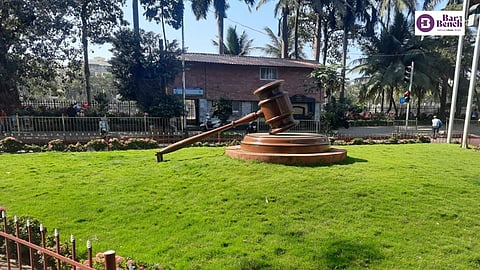
- Latest Legal News
- News
- Dealstreet
- Viewpoint
- Columns
- Interviews
- Law School
- Legal Jobs
- हिंदी
- ಕನ್ನಡ

For the past few years, there has been a constant demand for courts in India to either reduce or do away with vacations, considering the huge backlog of cases and deficit of judges.
A petition was filed in the Bombay High Court asking the courts to reconsider the vacation period, as it was a violation of fundamental rights of litigants. The matter is still pending.
There was also a recommendation by a Parliamentary Committee that judges should take leave at different times through the year so that courts are constantly open and there are always benches present to hear cases.
However, on many ocassions, judges have countered these demands, citing a number of reasons.
In August 2022, then Supreme Court judge Justice DY Chandrachud remarked that judges sit beyond court working hours in their chambers for research and judgment writing.
Supreme Court judge Justice Sanjay Kaul reiterated this sentiment at an event when he was asked whether courts should reduce their breaks in order to tackle pendency.
Justice GS Patel of the Bombay High Court highlighted the fact that judges worked long hours when he refused to grant urgent hearing for a matter, pointing out that he worked for "19 hours a day."
The most recent observation was made by the Delhi High Court's Justice Prathiba Singh, who said that judges in fact have to put in 14 to 15 hours a day, which made it very difficult for them to maintain a work-life balance.
Given how overworked our judges are, doing away with vacations may not be the right solution to remedy the problems of our justice system. However, the fact remains that days off have a bearing on the speed at which justice is dispensed. And groaning under the burden of over 4 crore pending cases, the system will benefit from as many working hours as possible.
In this light, the number of days for which our courts work bears significance.
So just how many days of vacation do courts in India enjoy per year?
We examined the calendars of the Supreme Court of India and certain High Courts of the country for the year 2023 to find out the exact number of court working days, which is the number of days judges sit and hear matters.
The term 'court working days' for the purpose of this article does not include days when the registry of a court is open. It also does not include dates where certain benches hold special sittings to hear important or urgent matters.
Holidays declared after an emergency or calamity have also not been taken into account. Only holidays which have been declared in the calendar at the start of the year have been considered.
Gazetted or notified holidays include nationwide celebrated festivals, national holidays, state-specific festivals and local holidays.
Supreme Court
A preliminary study showed that the Supreme Court, which is open for a little under 200 days a year, has the lowest number of court working days among all constitutional courts.
The apex court has a significantly higher number of notified and gazetted holidays for various festivals, given its national nature.
It has the longest summer vacation - comprising 6 weeks - and a winter break of 2 weeks.
High Courts
Most High Courts are also open for a little over 200 days a year.
For the year 2023, the Rajasthan High Court had the highest number of working days (214), followed by the High Courts of Madhya Pradesh and Karnataka, which had 212 working days.
The High Courts of Calcutta and Allahabad had 211 working days, while the High Courts of Bombay, Delhi, Madras, Kerala, Gauhati, Gujarat and Punjab & Haryana had 210 working days in 2023.
The Madhya Pradesh High Court had the least notified or gazetted holidays - 48 in a year.
The Calcutta High Court had the second least notified or gazetted holidays among all High Courts. It has only a 2-week long summer vacation, but it has a 4-week long break during Durga Puja and Diwali.
While the Bombay High Court has a 5-day-long break for Ganesh Chaturthi, it tries to compensate for some of those holidays by sitting on some Saturdays. It also has a 2-week long winter break during Diwali, which is longer than what most High Courts observe.
The Gujarat High Court has the maximum number of holidays arising from gazetted or notified holidays.
Both the Bombay and the Gujarat High Courts peculiarly declare additional holidays around certain festival dates close to weekends in order to extend the weekend. These additional days are then compensated on some Saturdays.
The High Courts of Gauhati, Karnataka and Allahabad have some 15 restrictive holidays. These holidays apply to the staff in the registry, who can choose to avail of those holidays by applying for the same.
According to the Allahabad High Court calendar, the holiday of Eid is limited to Muslims and Christmas is limited to Christians only.
Though there are persuasive arguments on both sides, the discussion on reducing or scrapping vacations or court holidays can only take place once the courts are functioning at their full sanctioned strength.
Vacancies lead to burden on the existing judges, who have to work more to compensate.
When he was Chief Justice of the Bombay High Court, Justice Dipankar Datta perhaps summed up a judge's predicament while responding to requests made for accommodating more urgent hearings.
"Where are the judges? Every month, every 15 days we are losing one of our colleagues (due to retirement)… Review meetings say “ask your judges to sit on Saturday.” They are already overburdened, they have to sit till 7-8 pm everyday, on Saturdays. I cannot put more burden on my brother judges", the now Supreme Court judge had bemoaned.